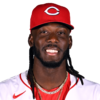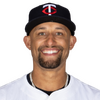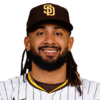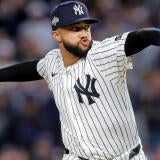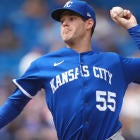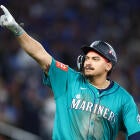2024 Fantasy Baseball Draft Prep: 27 biggest questions for the new season as pitchers and catchers report
Here are the big storylines going in

Pitchers and catchers are reporting this week, and you're ready to talk ball.
Welcome to the party, pal. Been here for months.
But since I'm the accommodating sort, I'll go ahead and give you the rundown of the biggest questions you should be asking heading into your draft prep, some of which are likely to be resolved in spring training. And just for good measure, I'll weigh in with my opinion from time to time as well.
What are friends for if not that?
1) Is 'The Glob' here to stay?
By The Glob, I'm referring to the increasing number of blowup starts across the entire pitching spectrum, but more specifically, I'm referring to their effect on the middle ranks at starting pitcher. All that volatility without those ace-like high-end outcomes to counteract it reduced that entire swath of pitchers to random number generators, each one's ERA being only as good as his last start. Whenever you thought you had a handle on who was better or who was worse, a sledgehammer would swing in to smash it all to bits, effectively rendering that span of 50 or so pitchers indistinguishable -- hence, The Glob.
It would be easier to dismiss as a one-year phenomenon if it hadn't coincided with a series of rule changes. The league eliminated the shift, which led to more baserunners. It limited pickoff attempts, which led to more aggressive baserunners. It also introduced a pitch clock that forced pitchers to maintain a high tempo when things began to spiral. And spiral they did.
Still, even if it's true that those changes brought about The Glob, we're now in Year 2 of those changes. Pitchers may have developed better coping mechanism to reduce those blowup starts and create clearer distinctions within The Glob. How you think it'll play out will change how particular you are about your pitcher picks in the middle stages of the draft. I've been emphasizing strikeouts, figuring those will translate either way.
2) Will Elly De La Cruz figure it out?
In his first half-season as a major-leaguer, the 21-yer-old delivered an exit velocity reading higher than all but two players, an average sprint speed higher than all but one player and the hardest-thrown ball by any infielder in Statcast history. It's a tantalizing toolset that gives De La Cruz as much upside as anybody this side of Ronald Acuna, but optimizing it is easier said than done. His 33.7 percent strikeout rate contributed to a .191 batting average after the All-Star break, and his 53.9 percent ground-ball rate put him on only a 20-homer pace (presuming 150 games). Still, as long as he's good enough to keep his job, I'm thinking he'll steal 50-60 bases, and that alone is enough to justify a fourth-round cost, if not higher.
3) Was Cole Ragans for real?
In a breakthrough that almost ceretainly slipped by our more Fantasy Football-minded readers, Ragans claimed a spot in the Royals rotation last August and proceeded to go 5-2 with a 2.70 ERA, 1.06 WHIP and 11.6 K/9 in 11 starts. The performance coincided with the introduction of a slider that immediately became his best swing-and-miss pitch, rounding out a deep arsenal headlined by a high-octane fastball. His Head-to-Head point-per-game average during those 11 starts bettered every full-season mark other than Gerrit Cole and Spencer Strider, so it seems we may have an ace on our hands.
But there isn't much of a track record to speak of, in part because he's had Tommy Jhon surgery twice, and even within the dominance, there were lapses in control, including one crazy sequence in which he threw three straight wild pitches. I'm as high on Ragans as anybody, mostly because The Glob (see above) incentivizes selling out for upside, but the concerns are well founded.
4) Just how good will Yoshinobu Yamamoto be?
What's amazing about Yamamoto is that while he's the most decorated pitcher ever to come out of Japan, having three times won their equivalent of the Cy Young and MVP awards, he's still only 25. His scouting reports read like a composite of pitcher superlatives from all across the league (the splitter of Kevin Gausman, the curveball of Max Fried, the control of George Kirby, etc.), and his highest ERA the last three years was 1.68. He also arrives without any durability concerns, which we couldn't say for Kodai Senga last year, remember. The baseball on this side of the Pacific has a different feel than the one he's used to, but he acclimated to it just fine in the World Baseball Classic last year. From everything we can assess right now, he seems without flaw, which will make it something of an upset if he doesn't perform like an ace right away.
5) Will Shohei Ohtani's return from elbow surgery go without a hitch?
You may have heard Ohtani had Tommy John surgery late last year, which would have been his second in five years. But it was actually some other, less extensive procedure to address the ligament damage in his elbow -- something so new that it doesn't even have a name, according to his agent. Without any comparables, it's hard to know what to expect, but there aren't supposed to be any limitations on Ohtani to begin the year. Of course, he won't be pitching at all, but we've already seen him thrive as a hitter while contuing to rehabilitate his elbow following his actual Tommy John surgery in 2018.
It's important to remember, though, that our expectations were lower then. Ohtani hadn't yet broken out as the MVP-caiber hitter he's been the past three years. These days, he's a first-rounder and remains so in spite of the risks. I think back to Bryce Harper last year (who, granted, was coming off full blown Tommy John) and how he needed roughly half a season to regain his power stroke, homering just five times in his first 76 games. Maybe Ohtani is just built different, but unless he dents up the scoreboard this spring, I'll probaby shy away in Round 1.
6) Which of the four uber prospects will make the opening day roster?
The prospects in question are Brewers outfielder Jackson Chourio, Orioles shortstop Jackson Holliday, Rangers outfielder Wyatt Langford and Rays third baseman Junior Caminero. Ignoring Yoshinobu Yamamoto, who's only a prospect by technicality, they're the top four on most every rank list, and the order I've listed them here is what I consider to be their likelihood of making the opening day roster. But they all have a chance. The latest CBA a couple years back introduced draft pick incentives that only come into play when a prospect is on the big-league roster for his entire rookie season, and since its implementation, we've seen an increasing number of top prospects make the team out of camp.
Chourio seems like a lock after signing an eight-year deal this offseason, rendering any service time manipulation considerations moot. The Brewers have left center field wide open for him, too. He's a power/speed threat in the mold of Julio Rodriguez and could have a significant impact in what will only be his age-20 season. Holliday is also 20 and, likewise, has a clear enough path with the Orioles, who recently confirmed he's in the mix for a roster spot this spring and will even get some exposure to second base to allow for more lineup permutations.
Langford and Caminero are knocking on the door as well, but it's harder to see where they fit for the Rangers and Rays respectively -- not impossible, mind you, but harder. Caminero actually spent some time with the big club late last year, which is usually a precursor to an opening day assignment, but the Rays are crowded at the corners already. Unless he gets extensive playing time at shortstop this spring (which wouldn't be such a crazy development), Caminero will probably have to wait his turn.
7) Can Cody Bellinger do it again?
You could say it was a long time coming for Bellinger, who was a rising star his first three years in the league and actually won NL MVP in 2019. His 2023 was a return to that form, at least by the top-line numbers, but if you dig a little deeper, you'll find that he wasn't actually hitting the ball that hard. It explains why he was one of the 10 biggest overachievers by xBA (.268 vs. his actual .307 mark) and one of the five biggest overachievers by xSLG (.434 vs. 525). In fact, his average exit velocity and hard-hit rate were both the worst of his career, which really calls into question the legitimacy of the performance. Then again, the only thing harder to explain than his bounce-back 2023 is how he hit .203 with a .648 OPS in the three years that preceded it.
8) Is Royce Lewis everything we dreamed he would be?
He's certainly being drafted like it, going off the board in the Round 5-6 range even though he's played all of 70 games, divided between two seasons. His 15 home runs in his final 32 games last year (postseason included) are no doubt fueling that enthusiasm, but it's also worth pointing out he's been a high achiever at every level since first tearing his ACL in 2021. And of course, Lewis was the first overall pick in the 2017 draft, so his delayed arrival makes the reward sweeter in a way. The cost this year is a tad aggressive given his injury history -- and I certainly wouldn't take him over an early-round mainstay like Manny Machado -- but I'm mostly on board with Lewis as a breakout player.
9) How will the Reds infield shake out?
You may have heard that too many cooks spoil the broth. Well, in this case, the cooks are Reds infielders and the broth is all the home runs that come from playing at Great American Ball Park. Even if we're assuming Spencer Steer's move to the outfield means he'll never appear in the infield again (which is a touch final, if you ask me), that still leaves six players for four spots. All of Elly De La Cruz, Matt McLain, Noelvi Marte, Christian Encarnacion-Strand, Jeimer Candelario and Jonathan India -- the first four of which are popular beakout picks -- deserve full-time at-bats, but there's a scenario by which none of them get them. The DH spot should relieve some of that burden, and my hope is that one Reds infielder or another occupies it every day. But they also have three left handed-hitting outfielders -- TJ Friedl, Jake Fraley and Will Benson -- who've earned the right to play against righties at least, which could mean Steer takes some of those DH at-bats.
Of all the hitters in the Reds infield mix, I'm most confident in De La Cruz's, McLain's and Candelario's playing time, though it's contingent on their performance, of course. I'm least confident in Encarnacion-Strand's, India's and Steer's.
10) Will Yankee Stadium put Juan Soto back on the right path?
For all the hand-wringing over Soto's time in San Diego, his .275-35-109-97-12 line made him the No. 14 overall hitter in 5x5 scoring last year, and with all the walks, he was of course top 10 in points leagues. So there's a frivolty to this question that I reject outright. But as justification for him being drafted in Round 1 rather than Round 2 this year, allow me to point out that he's a career .231 hitter with a .783 OPS at Petco Park, where he was forced to play his home games the past year and a half. On the road last year, he hit .307 with 23 homers and a 1.026 OPS, which is very much in line with the Soto we saw all those years in Washington. And he's not just going to someplace better than Petco. He's going to the second-best home run venue for left-handed hitters the past three years.
11) How long before we see Corey Seager?
Word of Seager's hernia surgery came out in late January, ending his chances of being a first-time first-rounder in Fantasy. It's an injury he played through during the World Series -- and rather well, it's worth noting -- but given the timing of the surgery, his availability for opening day is in doubt. In fact, the typical timeline for this pocedure is 6-12 weeks, which potentially puts him out for all of April as well.
GM Chris Young described his concern level as "very low," but it seems like Seager could have trouble maintaining his core strength while recovering from this procedure. And a loss of core strength can have a ripple effect on a player's health and performance. It could be that he's back on opening day, looks like himself right away, and nobody ever thinks of this again, but out of an abundance of caution, I'm waiting until late Round 3 to draft him.
12) Is Blake Snell going to burn us again?
Snell is like Cody Bellinger in that he returned to elite standing after years of falling short, actually winning his second Cy Young award, but he's also like Bellinger in that it's hard to explain how he did it. It certainly wasn't by throwing more strikes. Snell's 5.0 BB/9 rate was his worst since his rookie season and among the worst we've ever seen from a Cy Young winner. He also had a 3.71 xERA compared to his 2.25 ERA, making him the single biggest overachiever in that metric among starting pitchers.
There were stretches in between the two Cy Young awards when he looked like he was back to ace standing only to play us all for suckers. This may be the ultimate instance of that. Then again, the one thing he delivers consistently is strikeouts, which is the one pitching contribution you can count on in this new globby world we occupy. I'm tempted to draft him in spite of myself.
13) Can Carlos Rodon and Cristian Javier get back on track?
What makes evaluating Rodon and Javier so difficult is that you can't point to some hidden bit of info that reveals they were secretly good last year. They were terrible, and everyone who drafted them was mad. It's that latter point that makes them so enticing in drafts. They're being heavily discounted for two pitchers who were regarded as aces and strikeout artists just year ago. And whatever they lost may not be gone for good.
I'd be more dismissive if either pitcher's velocity had plummeted, suggesting that something in their physiology was broken, but their issues seem correctable. Rodon has the easy excuse of battling a forearm strain early and a bad back thereafter. The Yankees have already said his delivery was out of whack as a result. Javier's issues stemmed more from changes to the secondary characteristics of his fastball. The pitch lost some of the rising effect that made it so potent, but that also seems like an instance of him doing something wrong as opposted to not being able to do right anymore. Some time in the lab could fix it.
14) Will Fernando Tatis enjoy a Ronald Acuna-like resurgence?
For as good as Acuna was in 2023, turning in arguably the best Fantasy season ever, it's easy to forget that his 2022 was a massive disappointment. In fact, in this same article a year ago, I questioned how confident we were in Acuna bouncing back. What made it seem likely is that he'd be another year removed from ACL surgery, closer to full strength and back in tune with his mechanics.
Well, Tatis wasn't coming off ACL surgery last year, but he was coming off wrist and shoulder surgeries. His quality of contact was still among the best in the game, and Statcast had him with a .281 xBA and .508 xSLG compared to his actual .257 and .449 marks. I make the Acuna comparison because the two were 1 and 1A before their injury troubles started, both capable of delivering massive home run and stolen base totals. If Tatis' 2023 was just a warmup the way Acuna's 2022 was, then he could turn out to be the rare first-round discount.
15) What the heck, Vladimir Guerrero?
For a second year in a row, we paid a first-round price for Guerrero and got less-than-first-round results. In fact, it was worse this time -- he performed more like fifth-rounder. I could make all the same excuses for him them this time around. His Statcast page is still splashed in red, and in fact, his .295 xBA and .498 xSLG were actually an improvement from a year ago. But something about his spray angle in that home park just isn't translating to production. Seeing as he's 24, he's likely to figure it out at some point and get back to the MVP numbers he delivered in 2021, but he's not getting the benefit of the doubt anymore, being drafted in Round 3 on average. I'm in at that price.
16) Could stolen bases increase even more?
What, a 40 percent increase from one year to the next, yielding the biggest league-wide stolen base total since 1987, wasn't enough? It's only a theory, but hear me out. This increase was obviously by design. New rules were introduced to promote more stolen bases, the biggest being that pitchers could only attempt two pickoff throws per at-bat. A third failed attempt would result in a balk, which would be just as bad as a stolen base, making the pitcher unlikely to throw over even if the runner had a huge lead.
I'm not sure runners exploited it to the fullest extent. It stands to reason many were feeling their way through this rule change in Year 1, not wanting to push the limits just yet, and we saw a number of players up their stolen base output in the second half, once they had gotten the hang of the new rules. Specifically, I'm thinking of CJ Abrams, Andres Gimenez and Ha-seong Kim. I have an appreciation for the law of averages and generally think that every outlier is bound to regress, but since my theory about stolen bases last year proved accurate, let's endulge this one as well.
17) Which of the four standout sophomore hurlers will take the next step?
The hurlers in question are Eury Perez, Grayson Rodriguez, Bobby Miller and Tanner Bibee. That's the order in which I'd draft them, but they're packed tightly together in my rankings, just beyond the 25 pitchers who I feel like we can trust for near-ace production. They're practically there, in other words. All four impressed as rookies, with three improving their performance as the year went on and the other, Perez, flashing the most upside with three pitches boasting better than a 45 percent whiff rate.
Where these four could fall short is workload. Like most top pitching prospects these days, they've been coddled for most of their careers, and we won't know if they can take on an ace workolad until we see it happen. Having said that, Perez surpassed 120 innings between the majors and minors last year, Miller surpassed 130 innings, Bibee surpassed 150 innings and Rodriguez surpassed 160 innings. Once again, they're practically there.
18) Will Michael King's and Nick Pivetta's late-season success translate to a full season?
More seem to question Pivetta, possibly because there's more failure in his history, but durability could be a real issue for King, who had trouble holding together for a full year even while working in relief. What's most encouraging for him is that in his first real test as a starter, the stuff translated perfectly. His velocity held steady, and in fact, he was able to make better use of his four-pitch arsenal over multiple innings. He won't sustain the 1.88 ERA, 1.10 WHIP and 11.3 K/9 he put together in eight starts to end the year, but will he be good? If he stays healthy, I don't see why not.
At about a four-round discount, I prefer to draft Nick Pivetta, who really zeroed in on throwing strikes during a midseason banishment to the bullpen and went on to deliver 3.30 ERA, 0.96 WHIP and 12.5 K/9 in the second half, ending the year with back-to-back seven-inning gems.
19) Have closer committees outstayed their welcome?
As I wrote in my how-to guide for drafting relievers this year, it's like the league collectively admitted its exhaustion with the whole committee approach last year, wanting to simplify in-game decision-making. Even longtime holdouts Kevin Cash and Rocco Baldelli suddenly became predictable with their ninth-inning bullpen usage, sticking to Jhoan Duran and Pete Fairbanks (when he was healthy), respectively. As of now, most teams have a reliever who legitimately deserves to close and has already been installed in that role, leaving little room for upheaval at the start of the year.
By my count, there are 18 quality closers with a clear claim to the role and another four who are pretty close to being locks. That's about twice as many as a year ago, and again, since they by and large earned those roles on merit rather than happenstance, there's not a lot of incentive to pay up for one over another. I don't know if it's just a blip or if managers have actually moderated on the whole leverage thing, but I can tell you drafting relievers this year isn't nearly as stressful as the past few years.
20) Will Walker Buehler and Shane Baz be as good as new?
Both are coming back from Tommy John surgery, and both will have had more than the typical 18 months to recover by the time the season begins. It sounds, though, like both could be delayed, not so much for recovery reasons but for preservation reasons. The Dodgers and Rays both have their sights set on October and want their best arms available for the playoffs. Meanwhile, neither Buehler nor Baz is expected to take on a full workload after such a long layoff. The Dodgers have already confirmed that they plan to hold back Buehler at the start of the year. The Rays play things closer to the vest, but Baz wasn't accustomed to a big workload even before the injury, still being in the early stages of his career.
Baz was, however, arguably the top pitching prospect the last time he qualified as one and had put his bat-missing ability on display in the majors already. The procedure has a good enough track record that I'm counting on him making a signficant Fantasy impact in 2024. It's just a question of when. Buehler's situation is more complicated because it's his second Tommy John surgery, and he was showing diminished stuff prior to the procedure, his strikeout rate dropping in back-to-back years. It's a bit of a chicken-and-egg conundrum -- perhaps the declining strikeout rate was the first sign of trouble for the elbow -- but it doesn't change that you can't be totally sure what you're geting from him. Between that and the delayed start, I'm likely to fade Buehler in drafts.
21) How long before Robert Stephenson overtakes Carlos Estevez?
Stephenson might have been the best reliever in baseball after joining the Rays last June, putting together a 2.35 ERA, 0.68 WHIP and 14.1 K/9 with the addition of a new cutter. Meanwhile, Estevez had a 6.59 ERA and 1.76 WHIP in the second half and has long struggled with command. Seems like only a matter of time.
22) Will Oneil Cruz be impacted by last year's leg injury?
Sort of last year's version of Elly De La Cruz, Cruz showed early signs of bringing his strikeout rate down to a more reasonable level before destroying his ankle on an ill-fated slide. The original timeline was four months, but since he never actually made it back, we can't be sure he'll be athletically whole.
23) Is there anything to see with Erick Fedde?
Once a back-end starter with the Nationals, Fedde joins the White Sox after dominating the Korean league with a 20-6 record, 2.00 ERA, 0.95 WHIP and 209 strikeouts in 180 1/3 innings. It's the same league that put Merrill Kelly on the map, but of even greater note is how Fedde remade his arsenal in the mold of Logan Webb, posting a 70 percent ground-ball rate.
24) Will the Dodgers go with a a six-man rotation?
For as much work as the Dodgers put into their starting rotation this offseason, they already had some interesting up-and-comers in Emmet Sheehan, Gavin Stone and Kyle Hurt. They may end up needing all of them anyway given the health history of Tyler Glasnow, James Paxton and Walker Buehler (the last of whom we already know won't be in the rotation at the start), but some on the Dodgers beat have floated the possibility of a six-man rotation.
25) Have we entered the golden age for catchers?
Already there seems like an abundance of wealth with the emergence of William Contreras, Yainer Diaz Cal Raleigh and Jonah Heim the past couple years -- and those weren't even the prospects we were excited about. If Francisco Alvarez, Logan O'Hoppe, Bo Naylor and Luis Campusano take the next step forward this year, as many expect, there will be more quality catchers than could possibly be rostered in a one-catcher league.
26) How will the Padres and Phillies fill their closer vacancies?
Both have been non-commital as to their plans for replacing Josh Hader and Craig Kimbrel, and neither has brought in an obvious successor with an extensive closing track record -- not in the U.S., anyway. But Yuki Matsui starred in the role in Japan, making him the most logical choice for the Padres, and Jose Alvarado has long been considered a closer-in-waiting with the Phillies. Because both are left-handers, they may start out as part of a tandem, with Robert Suarez (Padres) and Jeff Hoffman (Phillies) also factoring, but over the long haul, well, it's clear who my favorites are.
27) Who gets left out for the Rays?
One complication for getting top prospect Junior Caminero on the opening day roster is that the Rays already have Isaac Paredes and Yandy Diaz entrenched at the corners. Another is that they also have Jonathan Aranda and Curtis Mead waiting in the wings. Aranado and Mead are older than Caminero, have also appeared in the majors already and are completely deserving of their own opportunity. Both have dabbled at second base, and the DH spot remains open as well. Still, it seems likely each of these three will undermine the others' Fantasy value, as well as potentially Paredes'.

